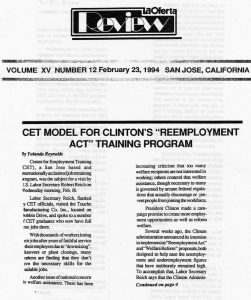February 24, 1994
By Yolanda Reynolds

Center for Employment Training (CET), a San Jose based and internationally acclaimed job retraining program was the subject for a visit by U.S. Labor Secretary Robert Reich on Wednesday morning, Feb.18.
Labor Secretary Reich, flanked by CET officials, visited the Touche Manufacturing Co. Inc., located on Dobbin Drive, and spoke to a number of CET graduates who have now full time jobs there.
With thousands of workers losing their jobs after years of faithful service of their employers due to “downsizing,” makeovers or plant closing, many workers are finding that they don’t have the necessary skills for the available jobs.
Another issue of national concern is welfare assistance. There has been increasing criticism that too many welfare recipients are not interested in working; others contend that welfare assistance, though necessary to many is governed by arcane federal regulations that actually discourage or prevent people from the workforce.
President Clinton made a campaign promise to create more employment opportunities as well as reform welfare.
Several weeks ago, the Clinton administration announced its intention to implement its “Reemployment Act” and “Welfare Reform” proposals, both designed to help ease the unemployment and underemployment figures that have stubbornly remained high. To accomplish that, labor Secretary Reich says that the Clinton Administration wants to lend a more focused sort of assistance to those seeking employment.
Following the tour of the Touche company’s operations, Labor Secretary Reich sat down with a few of CET graduates to discuss with them; what their jobs are within the company, what brought them to enter the CET training program, what it was that they were doing before they enrolled at CET, and what, in the CET program, was especially significant to them.
Reich said that he was in San Jose to learn. He explained that the CET training model has been recommended for replication across the nation as a key and realistic component for easing the unemployment and the under employment that clouds the nation’s future. (Especially when certain segments of the community, such as older workers, minorities, and workers with blue collar skills have extremely high rates of unemployment.)
Reich listened attentively to the students as they responded to his questions. Among those former CET students, new employees at Touche, who spoke to Reich were Katherine Bohanan, Salvador Blanco, Jose Hernandez and Angela López.
Touche employs approximately 250 employees and, of that number, about 50 are graduates from CET. Touche executive Tony Agredano serves on CET’s Industrial Advisory Board.
CET has a large and active industrial advisory board made up of representatives of valley companies, both large and small.
The students have had varied backgrounds both experience and ethnicity.
Katherine Bohanon’s experience was not unlike that of many workers that Clinton has described in his many speeches discussing how to get workers back on the job. Bohanon had worked for 13 years for a large electronic firm in Santa Clara County when, one day, she went to work and was told that she no longer had a job and to clear out that very day. Her job had been shipped overseas.
Bohanan said that she went on unemployment benefits and searched unsuccessfully for a job in electronics (where the pay had provided a living wage). She finally found some work at two minimal wage jobs but, with children and nearing the end of her 26 week benefit allowance had decided that she wanted one job so that she could be with her children a little while. A sister told her of CET.
At CET, she thought, that more training in her field would help her find another job – but her CET counselor advised her to train for other work where there was employment available. She enrolled in the bookkeeping program – finished after less than a year’s training, applied for and was offered a job at Touche and has been there for over three years. She earns more than twice the minimum wage and is paid benefits, including health benefits that she had lost when her job at the electronics firm was ended.
Another student, Jose Hernandez, described how he had worked in the fields, barely earning the minimum wage before finding work with Touche. He had dropped out of high school but continued with night and community college instruction to learn English. He enrolled at CET and in less than a year he finished his training in metal fabrication. He has been at Touche for several years, is now a supervisor and earns a very good hourly salary plus benefits.
Hernandez explained to Reich who, asked about his transition to management, that his experience at CET gave him the confidence necessary. He added “our teachers always said, you can do it.”
Angela Lopez described a situation faced by many of today’s young women. She became pregnant at a very early age, dropped out of school and was on welfare for twenty years. Lopez heard about CET and explained that besides offering training it provided child care as well, and
explained that it would have been impossible for her to attend any educational program without child care.
Salvador Blanco came to San Jose from Philadelphia and had done field work in Pennsylvania. He wanted out of field work and had been told that there were jobs in electronic in San Jose. He too, like Bohanan had a relative that knew about CET, where he insisted on enrolling in the electronics program.
Blanco eventually followed the advice of his counselor and switched to silk screening and graphic arts after winning a school wide poster contest. He too works at Touche where his graphics skills are used in the production of metal works.
Israel Banks described a life experience, too often, characterizes the lives of young males growing up in the ghetto and the barrio. Banks had come to San Jose on gang business but during his visit, discovered CET, where he enrolled in the Chefs program. This cooking program is not for “short order cooking” but for quality restaurant food preparation. Banks explained that he has finished the elementary introduction to food preparation and that he has just signed a three-year contract to work with a master chef, which will further add to his certification in that profession.
On CET’s instructional staff and advisory board are such local notables as Emile Mosher, who has been nationally recognized for his culinary creations at his restaurant, known as “Emile’s” in downtown San Jose.
From listening to the former students now all full-time employees, Reich commented that it appeared that there were four major aspects of the CET model which influenced the success of its training model. Reich said that the training offered at CET was in preparation for actual jobs and the close coordination with industry. Child care was provided. The program offered good counseling and the entire staff inspired self-esteem in its students.
Among the many San Jose who joined the tour were Congressman Norm Mineta, County Supervisor Zoe Lofgren, Ric Sawyer, former Executive Director of the San Benito/Santa Clara County Central Labor Council and now an official of the U.S. Department of Labor, and Terry Poche of U.S. Congressman Don Edwards’ office.
CET’s outstanding program is a source of pride, not only to those directly involved and to San Joseans, but also to those who provide it with funds. Dr. Phoebe H. Cottingham who is the Associate Director for Equal Opportunity for the Rockefeller Foundation who was present last
Wednesday explained that CET’ training model had become of special interest following an in depth assessment by the Foundation of the success of the various training programs around the country. She said that CET was singularly the most successful and that she was optimist that other programs would be established – some by CET or other training organizations and that plans for implementing similar programs were already underway in New York.
This past week CET was again host to job trainers from all over United States who will be studying the CET model in order to better provide the “one stop” job training that the Clinton administration believes will help facilitate the path to employment for many Americans.
The CET model was adopted several years ago by the World Bank. This past week there were job trainers as well from all over the United States and Canada.
Asked by La Oferta what the administration was doing to the disappearance of full time jobs that reappear as part-time or temporary jobs or for contract service and all without benefits, Reich responded that it was illegal to revert full time jobs to contract employment and that the Administration is looking into creating legislation that would require benefits on a pro rata basis for those employed in other than full time positions.
CET was founded in 1967 by long-time community advocates and allies Anthony Soto and Rush Tershey. CET has graduated over 60,000 students. Trainees are not considered graduates of CET until they have been on a job for three months. CET has put San Jose on the national and international itinerary as job training. Specialists visit the headquarters – some for as long as a week.
For more information in CET, they may be contacted by telephone at 287-7924. © La Oferta Newspaper.






